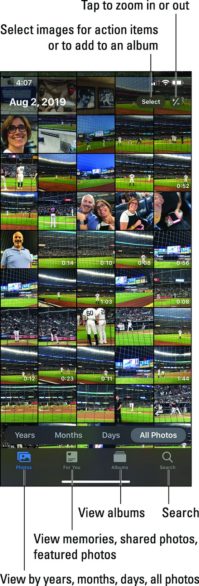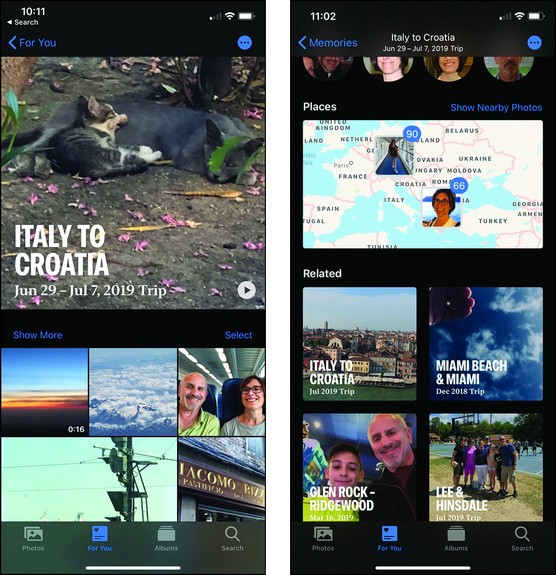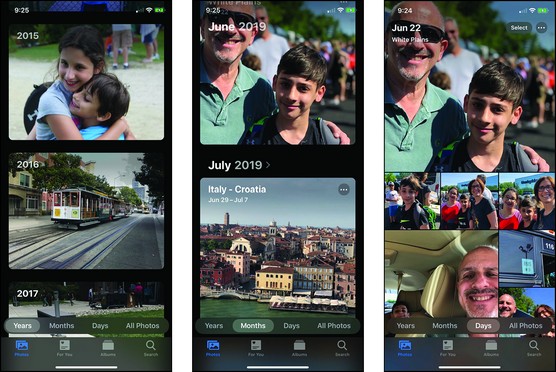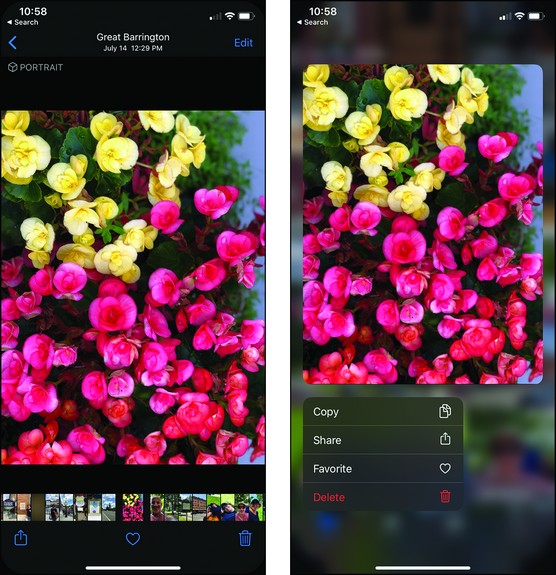The Photos app on your iPhone got a major makeover in iOS 13, highlighted in some of the views by a gorgeous interface that makes your best pictures pop. Images live in squares and rectangles of different sizes, with Apple using machine-learning technology to surface what it considers the best-looking shots.
Such views are worthy of Harry Potter as well because the revamped Photos app is largely about motion: Scroll or press your fingers against the display and videos and Live Photos do, well, what they're supposed to do.In the Photos or Camera app — you can get to the former by tapping a thumbnail image in the latter — you’ll also find pictures you’ve shared with friends and they’ve shared with you. The photos you imported are readily available too and are grouped in the same albums they were in on the computer.
Moreover, every picture you take with your phone (and other recent iOS devices) can be stored in iCloud Photos. You can access any of these pics if you have a Wi-Fi or cellular connection to the Internet. No more fretting about images hogging too much storage space on your phone.
What’s more, the pictures are stored in the cloud at their full resolution in their original formats. (Apple will leave behind versions that are ideally sized for your phone.)
You can still download to the phone images that you want available when you’re not connected to cyberspace.
Here, you learn not only where to find these pictures but also how to display them and share them with others — and how to dispose of the duds that don’t measure up to your lofty photographic standards.Get ready to literally get your fingers on the pics (without having to worry about smudging them). Open the Photos app by tapping its icon on the Home screen or by going through the Camera app. Then take a gander at the buttons at the bottom of the screen: Photos, For You, Albums, and Search.
 Recents and Favorites are among the albums found on your iPhone.
Recents and Favorites are among the albums found on your iPhone.
Choosing albums on your iPhone
Tapping Albums lists all the albums you have on your iPhone. Apple segregates such albums into various other albums or files: My Albums, Shared Albums, People & Places, Media Types, and Other Albums. Tap See All to dig into any of the picture collections that make up each of these sections.For now, visit the My Albums section, which is highlighted by a Recents album, as well as an album dedicated to a collection of your designated favorite pics. You’ll also see albums in the My Albums section that you’ve created yourself — makes sense given the name of the section — as well as albums that were synced from your Mac.
Now scroll down to the Shared Albums section: As the name suggests, you will find albums that you may have shared with other people, as well as the albums that other people have shared with you.
Drop down again and you arrive at People & Places, albums that are duly organized around the people in them and the places where the pictures were taken. In the Places section, pictures are lumped together and plotted on a map or in a grid.
 Finding iPhone photos by location.
Finding iPhone photos by location.
In the Media Types section under the Album tab, you’ll find image groupings for Videos, Selfies, Live Photos, Portrait, Long Exposure, Panoramas, Time-Lapse, Slo-Mo, Bursts, Screenshots, and Animated.
Under the Other Albums section, you'll find your iPhone’s photos organized by Imports, plus a grouping of photos that are typically hidden from view, and even pictures that have been recently disposed of, in case you change your mind about deleting them; plastered on top of these images are the days remaining before the pics are permanently deleted.
Viewing all of your iPhone photos
By tapping the Photos tab at the bottom of the Photos app, you’ll see all your pictures in one place. Tap that tab now and you see the minimalistic interface, which reveals the All Photos album. Digging into All Photos.
Digging into All Photos.
Browse the thumbnails until you find the picture or video you want, and then tap it.
You’ll know when a thumbnail represents a video rather than a still image because the thumbnail displays the length of the video.
If you can’t locate the thumbnail for a photo you have in mind, flick up or down to scroll through the pictures rapidly, or use a slower dragging motion to pore through the images more deliberately.As you scroll in either direction, you see the date that the pictures were shot and their location (if known). You will find the one you’re looking for soon enough.
Now locate the +/–zoom control in the upper-right corner of the screen. Tap + to repeatedly to enlarge thumbnails, which of course means fewer pictures will be visible on the display. Tap – for the opposite effect, so that more images, albeit teeny thumbnails in some cases, are within view.
To return to the list of albums, tap Albums at the upper-left corner of the screen.
After backing out, you can create a new album from the albums view by tapping the + in the upper-left corner and choosing a name for the album. Type that name and tap Save. (You could also create a shared album.) To select pictures (or videos) to add to your newly minted album, tap their thumbnails.
Memories for iPhone photos
Hidden in almost everyone’s photo collection are the crown jewels, those images that trigger the most precious memories. The For You feature, a holdover from iOS 12, can help trigger such memories automatically. Tap the For You tab to take a photographic trip down memory lane.How does it work? The iPhone Photos app smartly scans your picture library and collects images around vacations, birthday parties, and other special events, or what the app just deems are the best pictures you took during the year or a shorter time frame.
In the iPhone Photos app below, for example, the Memories feature under For You automatically built photo memories around a trip he took to Italy, Greece, and Croatia. Some Memories are generated around people too.
 Thanks for the Photos memories.
Thanks for the Photos memories.
Within such memories, you can play a Memories movie that the app automatically generates, complete with theme music, titles, and transitions.
You can also produce your own memories by tapping the right-pointing arrow next to an album.
Inside a memory, you can view pictures by the people in them or by place, with photos plotted on a map, and have the app show more pictures that relate to the memory. Tap Show More to summon thumbnails of iPhone photos. Tap Summary instead to have Apple select the pics for the memory, which as mentioned a moment ago, reside in different size squares or rectangles.
Scroll down to the bottom of a memory and you’ll see related memories. These are groups of photos that the app has determined connect somehow to the memory you’re already looking at, perhaps other trips you’ve taken or photos shot on the same date in a different year. Take a gander at the iPhone photo above to get a sense of how Apple jogs your photographic memories.
Indeed, in grouping photos into albums and such, Apple exploits advanced computer vision technology, using facial, object, and scene recognition along with location data to make intelligent choices.
You can tap a play button inside a memory to play it as a slideshow. And you have options for just how the sequence of pictures (and videos) plays back: You can choose dreamy, sentimental, gentle, chill, happy, uplifting epic, club, or extreme settings.
Depending on your selection, your iPhone will insert the appropriate music and fonts. Some advice: Experiment with these choices. You also have the option to play back the memory in a short, medium, or long sequence.
If you cherish any the memories that Apple has kindly put together on your behalf, tap the circle with the three dots in the upper-right corner of the screen, and tap Add to Favorite Memories in the menu that appears.
If you change your mind, tap Remove from Favorite Memories. And if you don’t like a memory from the start — perhaps it is too bittersweet — tap Delete Memory to wipe it from your own memory. You can even choose Block Memory. The menu also lists Play Movie and Share options.
Want to see memories built around holiday events in your home country? Go to Settings → Photos, and tap to enable the Show Holiday Events switch.
Categorizing photos on your iPhone
Placing pictures into photo albums seems like it’s been the way of the world forever. But albums per se are not the only organizing structure that makes sense.Apple has cooked up a simple but ingenious interface for presenting pictures that is essentially a timeline of pictures, grouped by years, months, and days, each providing a different roadmap to your photo library. You see tabs for these curated views near the bottom of the screen, all to the left of the All Photos tab.
Pictures categorized by years are indeed all the pictures taken in a given year. Can’t be more straightforward than that. From the yearly view, you can scroll in either direction to move to pictures shot in an earlier or later year. The fancy algorithms under the hood automatically choose cover photos to stand in for the years they represent.
If you tap the cover photo for a given year, it will be replaced by another, one shot in the same year but from an adjacent month. This mini slideshow continues with the cover picture, say, for August, followed by pictures from September, October and so on. When you reach the end of the year, the cover image reverts to January, then February, March, and so on.
Naturally, the months view is all about the pics snapped within a given month. Such pictures are clustered in collections, by date or location or both.And yes, the days view is just that: pictures taken on a specific day, with Apple again dressing the interface in those aforementioned different-sized squares and rectangles.
The iPhone photo below shows side-by-side-by-side views of years, months, and days groupings.
 View your iPhone photos by years (left), months (center), and days (right).
View your iPhone photos by years (left), months (center), and days (right).
Through all these views, you’ll see location information headings that get a tad more specific as you move from years to months to days, assuming your iPhone knows where the pictures were taken. (Location Services must be turned on under Privacy Settings.)
You can move from one view to another by tapping not only the tabs for Years, Months, and Days (as well as All Photos) but also the cover image. Tapping an iPhone photo in the years view shifts you to the months view. Tap an image in the months view and you move to the days view.
When you press down against pictures and thumbnails they swell, changing the view or the surrounding menus and icons. The menu that appears lets you copy, the image, share it, choose it as a favorite, or delete it.
A gentle tap instead summons a filmstrip that you can slide your finger against to rapidly skim through your iPhone photos. You also see icons at the bottom for sharing the picture, making it a favorite (the heart icon), or discarding it.
If you press harder, the image is instead accompanied by a menu with options to copy the picture, share it, make it a favorite, or delete it.
 You can share, choose a favorite, edit, or discard an iPhone photo.
You can share, choose a favorite, edit, or discard an iPhone photo.
Apple lets you optimize iPhone storage if you’re low on space by replacing full-resolution photos (and videos) with small device-sized versions. If you have plenty of room, you can download full-res originals. Go to Settings → Photos and tap either option so that a check mark appears.
Searching for pictures on your iPhone
iOS has one more feature to help you find a given iPhone photo among the thousands if not tens of thousands you’ve shot. You can search your iPhone’s entire photo library in the cloud. From the Photos app, tap the search icon, the one that resembles a magnifying glass.Apple has beefed up search over time through ever-more advanced versions of iOS. You can get search suggestions for special moments, people, places, and more, even before you start typing. Apple will also group pictures by categories (sports, animals, cars, and so on.)
Of course, you can also just type a search term with the on-screen keyboard, perhaps the date or the time a photo was taken or the location where it was shot. Your phone also comes with the capability to search pictures by what is in them: mountains, beaches, lakes, cats, whatever.
The app won’t get it right every time — some dogs were mistaken for cats when the latter was searched for. But it gets it right enough of the time that you can’t help but be impressed.
You can also enlist Siri to help you search for specific photos. For example, you might say something along the lines of “show me all the pictures I took at the baby shower.”
Needless to say, the iPhone Photos app has all the tools you need to remember all your wonderful memories.




